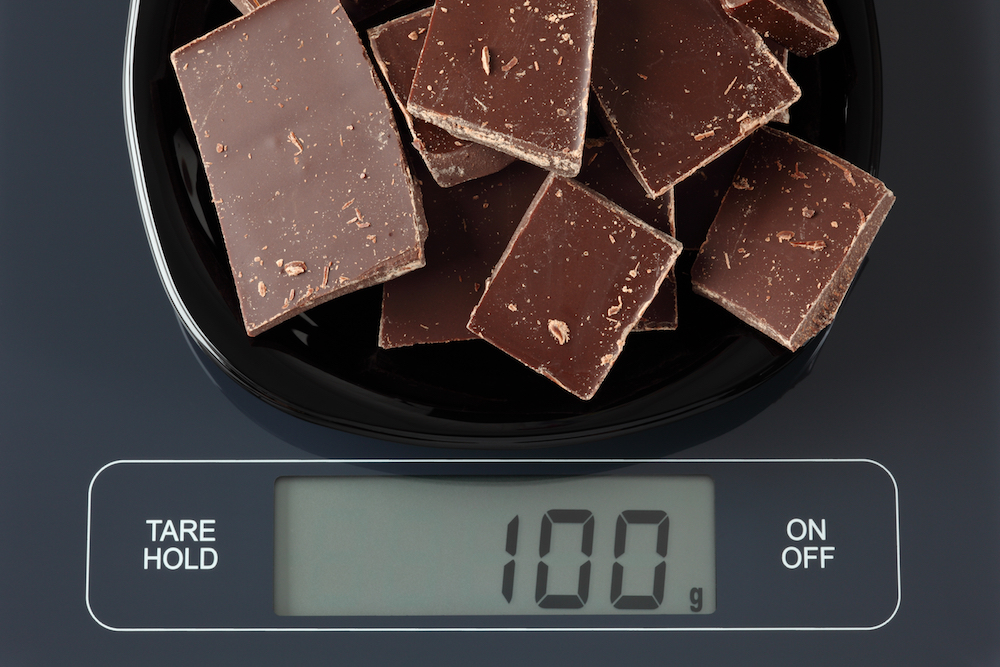
Sometimes, it’s the cheapest purchases we make that change our lives. For me, it was my $15 kitchen scale.
This might be old news to you if you live somewhere where home bakers use kitchen scales regularly. But in good ol’ ‘Merican baking, kitchen scales aren’t really a thing. I grew up baking with cups and teaspoons, and so did everyone else I know.
But a few years ago, inspired by my love of The Great British Bakeoff, I started getting really into baking bread. I wanted to bake some of the recipes that they were making on the show, so I looked them up online. Conveniently, the BBC’s website gives you directions for some of the recipes you see on the show!
…But all of the recipes used grams to measure the ingredients, not cups.
This was unfamiliar and confusing to me at the time. I didn’t have a scale, so the first few recipes I made were challenging and took twice as long as they should have, since I had to convert all of my ingredients to grams.
But why should this matter? Why is using a kitchen scale different than measuring cups? Is it easier to use a scale than cups?
Let’s look into it!
Volume versus weight
First off, you should know that scales and measuring cups are measuring two totally different things, which is why it was a little tricky for me to convert those BBC recipes. There’s no easy one-for-one conversion here.
Cups, tablespoons, and teaspoons measure by volume. That means you’re adding ingredients based off of how much of an ingredient can fit inside your measuring cup.
The thing is, the amount of an ingredient you get into your cup can change depending on how you scoop. For example, scooping flour directly from the bag can compact the flour into your measuring cup, giving you way too much! It can be hard to keep things perfectly consistent.
A scale, on the other hand, measures weight. 100 grams of flour is always going to be the same amount, no matter how you choose to scoop it. That means that a scale is more consistent and accurate.
This is especially important when it comes to baking. You’ve probably heard that “baking is an exact science,” right? Well, a scale can help your measurements be more exact!
Kitchen scales make for speedier baking
Not only is measuring by weight more accurate, it’s also faster.
You don’t have to fuss around with multiple measuring cups. You can just spoon, sift, or pour directly into your mixing bowl and watch the numbers go up. As soon as it hits the correct number, you’re done!
As well, you don’t have to worry about how you’re filling up your measuring cup, or whether you’re compacting too much of an ingredient into your cup.
It’s simple, foolproof, and speedy! Your bread will never be too floury or stodgy again! (Except that it probably will, because bread-making is part witchcraft.)
Which scale should I buy?
Okay, so enough about the merits of scales. Clearly they’re awesome when it comes to quick and accurate baking. But which one should you buy?
When looking at scales, you should consider a few things.
1. Weight capacity
First, you should make sure that your scale can handle the weight you want it to. Many scales out there seem to be able to handle a maximum weight of 5 kg (or 11 pounds). This is more than enough for an average home cook. But if you’re frequently cooking with large batches of ingredients, there are scales out there that can handle a bit more weight.
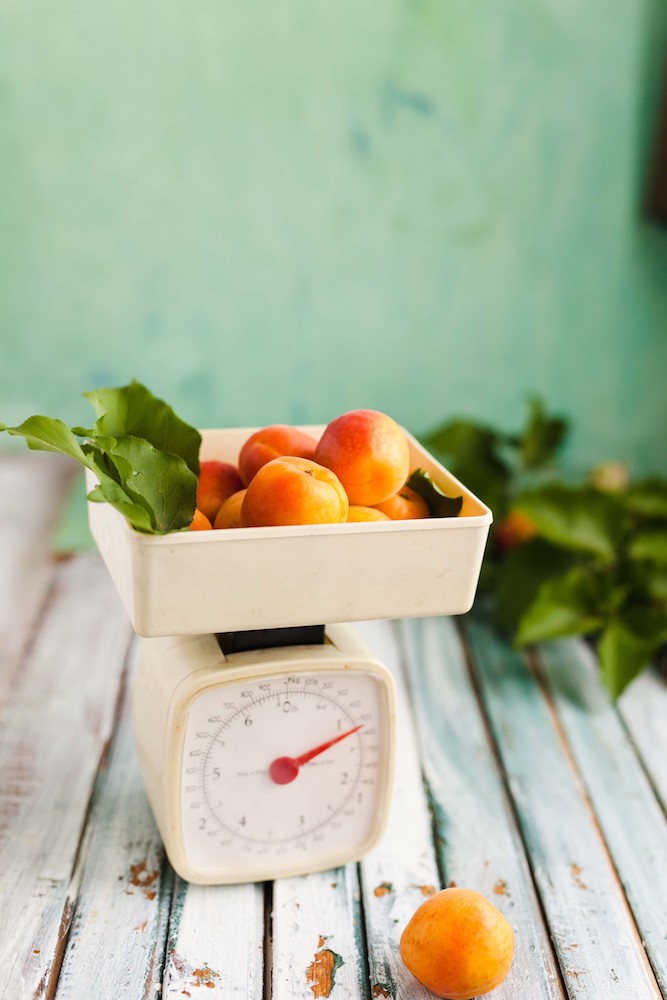
2. Digital versus analog
You’ll also want to consider if you want a digital scale or an analog scale.
Digital scales are awesome because they’re easy to read. Most also have a setting to switch around to a variety of different weight options (such as grams, ounces, and pounds).
Analog scales work with springs. They’re more visually aesthetic to leave out on the counter. They are also great if you want a durable option that will never run out of batteries or switch itself off.
However, you can’t change the units on the scale like you can with digital, and most analog scales only use two or three different units (usually, grams and ounces/pounds).
3. Price
You should also think about price. Scales on Amazon range from around $10 to $50.
If you’re a novice baker who bakes a few times a week or month, I’d probably go for an entry-level scale (scales that are around $20 or less). I purchased a very basic $12 scale, and it’s worked well for me for a year now. It’s small and not fancy, but it gets the job done just fine. (It’s also a good way to test out if you like working with a kitchen scale!)
Add on a few dollars, and you can get features like a larger measuring surface, a sleeker design, or a light-up LED display.
But if you’re a daily baker or someone who bakes large batches of food, I might recommend a hardier scale. A better-built, larger scale will fit in better with your kitchen and will last you longer.
How do I use a scale?
Okay, so you’ve made up your mind and purchased your scale. You’re about to use it for the first time, but you’re a bit confused. I understand. It can feel a bit intimidating at first, but I promise that it’s super simple!
Here’s a step-by-step guide to show you how I use my digital scale.
First, turn it on!
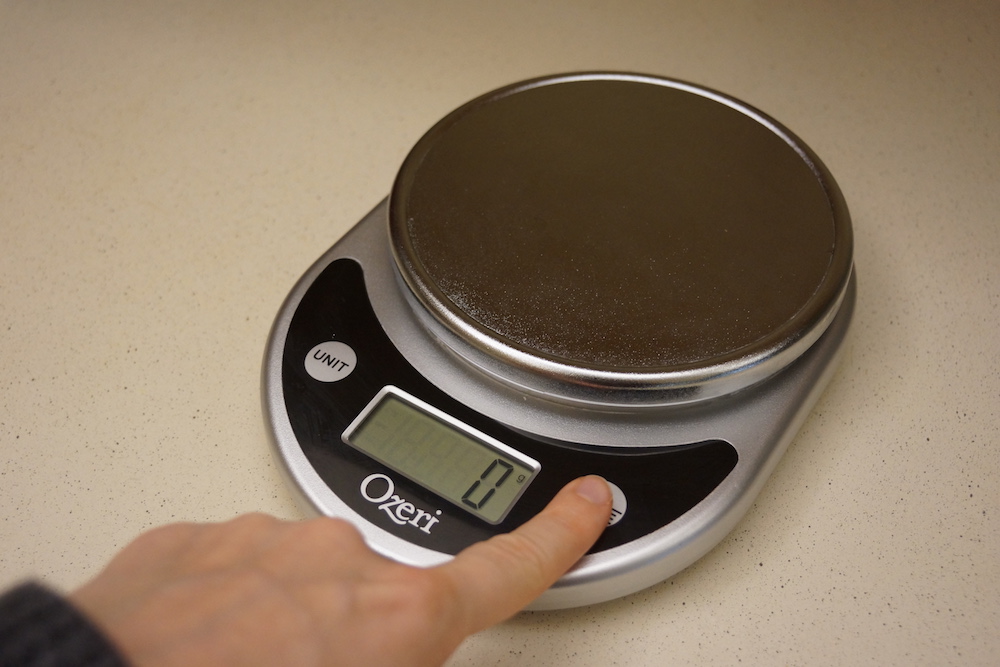
Use the unit button to switch to the correct measurement.
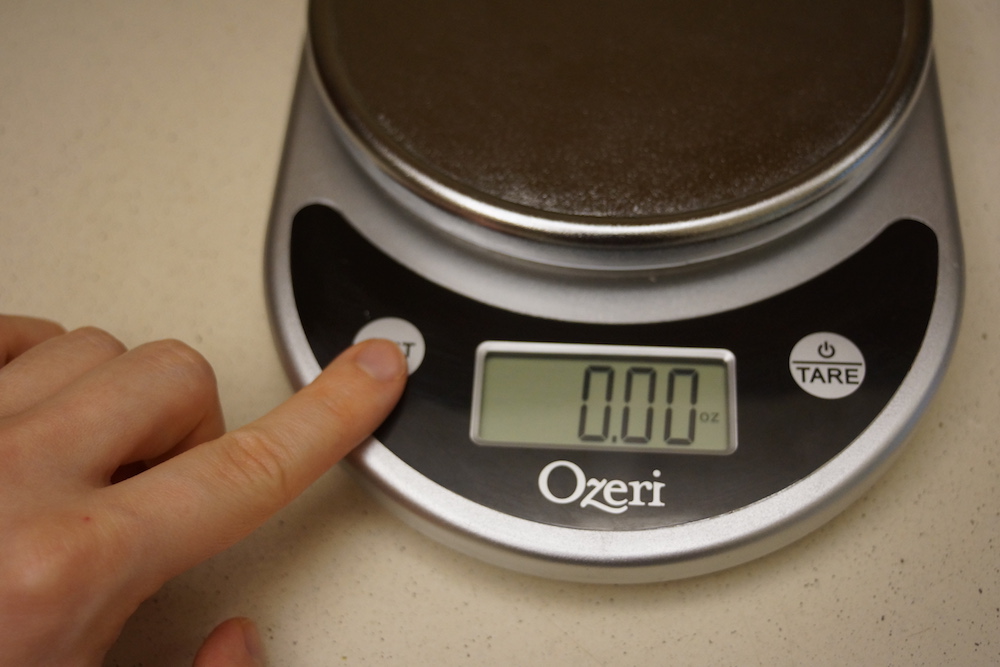
Place your mixing bowl (or other container) on top of the scale.
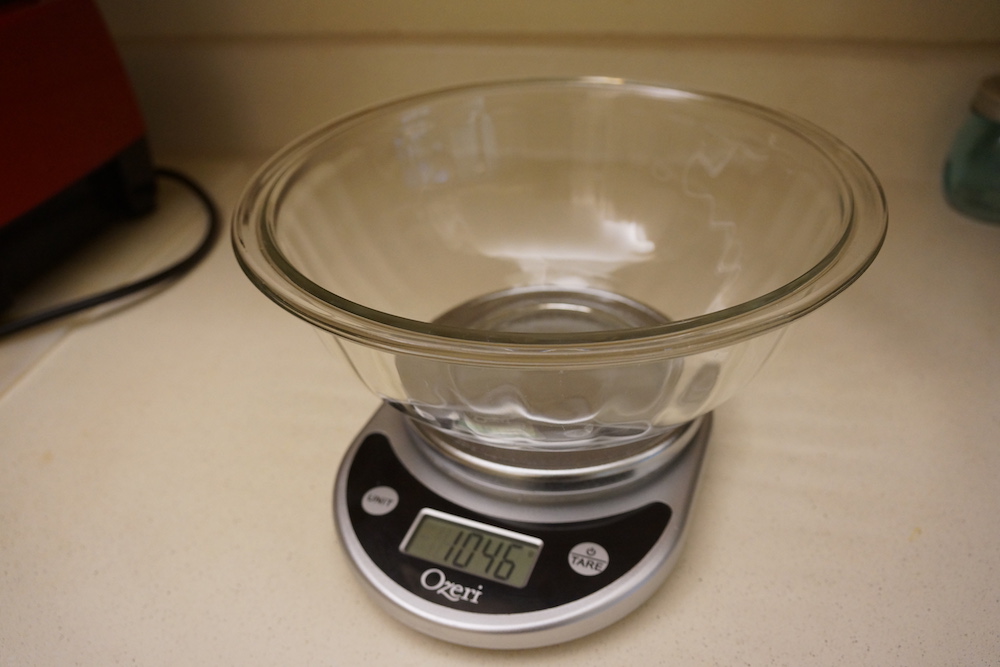
The scale will weigh the bowl’s weight, which you don’t want. Press the ‘tare’ or zero button to set the scale back to zero, which subtracts the weight of the bowl and starts you off fresh.
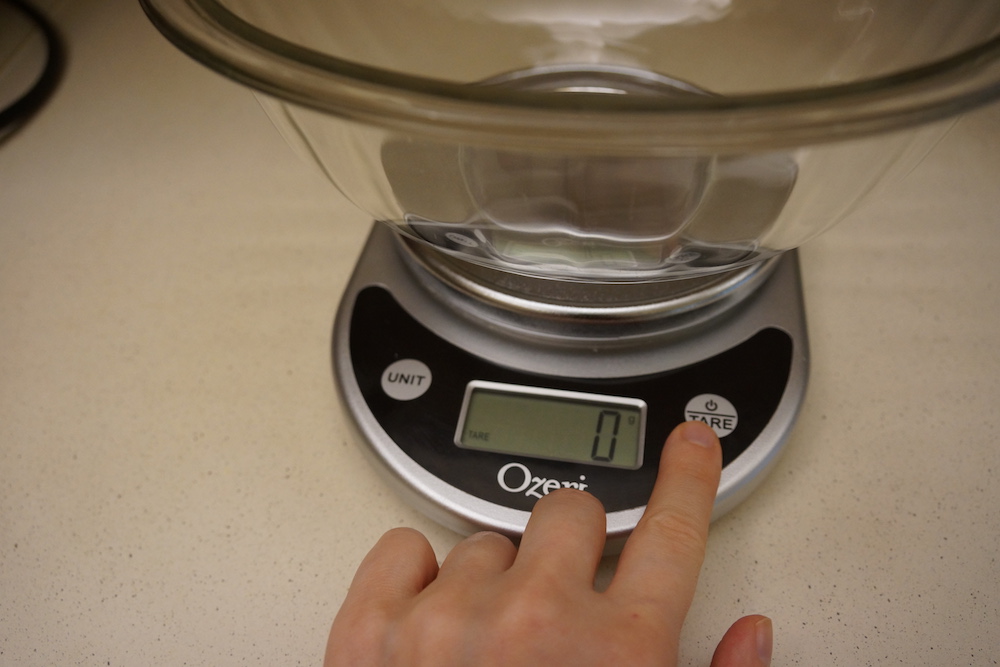
Add your first ingredient. Feel free to scoop, sift, or even pour from the original container! Keep an eye on the number on your screen, and stop adding your ingredient when you reach the number you want.
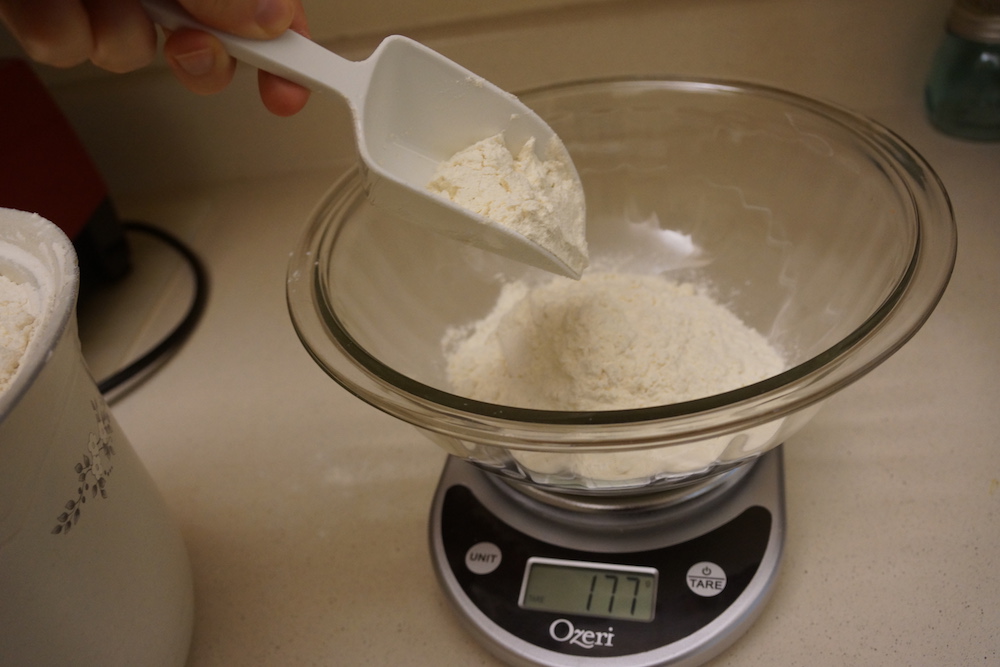
As before, press the ‘tare’ button to reset your scale back to zero. Repeat this process until you’ve measured all of your ingredients out.
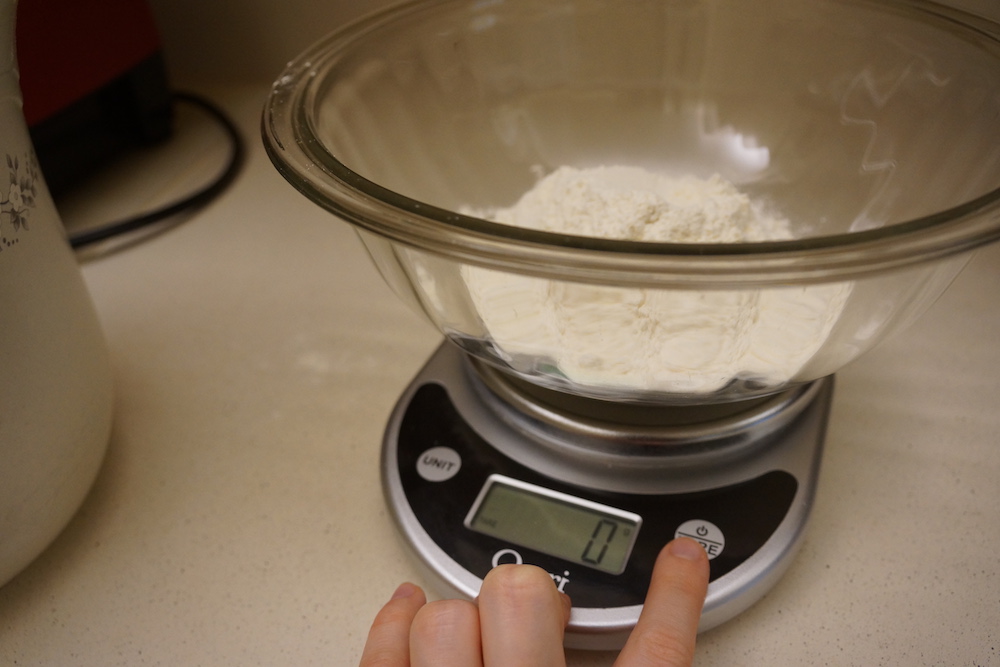
As you can see, it’s super simple, and even easier than working with measuring cups. You’re sure to get the hang of it in no time!
What should I do if my recipe uses cups instead of weight?!
Okay, let’s pause here. This post isn’t meant to say that you should throw out your measuring cups, or that you should never use cups again.
And honestly, even though I now prefer using recipes that go by weight, I still use my measuring cups if that’s what a recipe uses. It’s not as convenient, and it might take a bit longer, but you’ll still end up with tasty baked goods at the end of it.
However, if you do want to convert a recipe from volume to weight (or vice versa), there are several ways to do so.
As I mentioned before, there is no straightforward way to covert a recipe by just looking at it, as each ingredient has a different weight per given volume. For instance, a cup of flour weighs 125 grams, while a cup of sugar weighs 200 grams.
One solution here is to type each individual ingredient into Google to find the conversion. However, this is a lot of extra effort, especially for recipes that have a lot of ingredients. As well, it might be tricky to find conversions for more obscure ingredients.
Another solution is to have a paper copy of the recipe on hand. Make the recipe with cups, as the recipe is written, but put your measuring bowl on your scale. Write down the weight of each ingredient as you add it (making sure to hit the ‘tare’ button in between each measurement). By the end, you’ll have a successfully converted recipe!
The obvious downside to this second method is that you’ll need to make the recipe once by volume before you’re able to make it by weight. For that reason, this technique works best if you want to convert a favorite recipe that you know you’ll make over and over again.
What about measuring small amounts of ingredients?
I do have one exception to my stance on “weight is easier than volume.”
When you need very small amounts of ingredients like baking soda, salt, or vanilla, I’d recommend just sticking with measuring spoons. Kitchen scales can measure very light weights amounts, yes, but something like a quarter teaspoon of salt may struggle to register on your scale.
For that reason, I find it easier to measure very small amounts in teaspoons or tablespoons.
Conclusion
Kitchen scales are a wonderful addition to any baker’s kitchen, and I’d highly recommend you invest in one if you haven’t already!
Do you use a kitchen scale? What has been your experience? Let me know!

Leave a Reply
You must be logged in to post a comment.